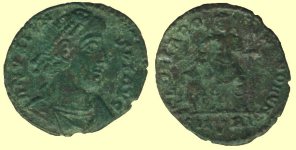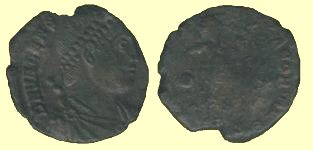
Valens 364 - 378 A.D.
By clicking on the pictures you'll be linked to a more complete description of the coin. At the bottom of this page there is a more elaborate biography of the emperor.
 |
Obverse: DN VALENS PF AVG |
| Reverse: GLORIA ROMANORVM | |
|
Fieldmarks: -
|
|
| Exergue: SM |
 |
Obverse: DN VALENS PF AVG |
| Reverse: GLORIA ROMANORVM | |
|
Fieldmarks: a * in the right field of the reverse
|
|
| Exergue: sε |
Valens 364 - 378 A.D.
Flavius Julius Valens was born around 328 AD at Cibalae in Pannonia. His father Gratianus was a soldier renowned for his strength and wrestling skills. After Gratianus retired, Constantius II confiscated his estates because he was suspected of having been a supporter of Magnentius. Gratianus' alleged affiliation with Magnentius apparently did not keep Valens or his elder brother Valentinian from being able to enter the military. Valens wasn't as successful as his brother but he eventually came to serve, under Julian and Jovian, in the household guard (Protector Domesticus). When Jovian died Valens brother Valentinian was an obvious choice as his successor, like Jovian, he was an Illyrian and he shared close connections with the protectores domestici who had promoted Jovian the previous summer. He was proclaimed Augustus on the 26th of February. As Valentinian prepared to make his accession speech, the soldiers threatened to riot, apparently uncertain as to where his loyalties lay. Valentinian reassured them that the army was his greatest priority. Furthermore, to prevent a crisis of succession if he should die prematurely, he agreed to pick a co-Augustus. On the 28th of March 364, he appointed his brother Valens as his co-emperor at the Hebdomon (just outside Constantinople). After only two months of co-rulership, the two departed from Constantinople for their native Illyricum. Outside Naissus, in Moesia, they divided their administrative staff between them and at Sirmium they did the same with their mobile forces. Valens was to rule the east, from Thrace in the North and Cyrenaica in the South eastward to the Persian frontier and Valentinian would rule the much more troubled west. They did not spend long in Sirmium and Valentinian moved on to his new capital Mediolanum, and Valens moved back to his capital Constantinople in December 364.
Valens first priority was to go to the east to attempt to restore the damage of Jovian's unfavorable peace with the Persians. However soon after he left a maternal cousin of Julian named Procopius managed to convince two army units passing trough Constantinople to declare him emperor. Although not very popular at first Procopius quickly and effectively used propaganda to gain favor. He spread rumors that Valentinian had died and he issued coinage to show his connections to the Constantinian dynasty, he further exploited dynastic claims by using the widow and daughter of Constantius to act as showpieces for his regime. Valens quite distraught at first quickly re-found himself but he couldn't act immediately since almost all his troops were occupied in Syria. Valens send two smaller units to deal with the usurper but Procopius quite easily managed to persuade them to join his cause. It took Valens till the spring of 366 to get an army together to seriously deal with Procopius, who hadn't been idle and had gained control of the dioceses of Thrace and Asiana. Valens first defeated Procopius' general Gomoarius at Thyatira he then met Procopius himself at Nacolea and managed to convince Procopius' troops to desert him. Procopius was caught and executed and his head was sent to Valentinian in Trevirorum for inspection.
After this success Valens launched a campaign against the Visigoths who had supported Procopius' uprising. In the spring of 367, Valens crossed the Danube at Transmarisca and devastated much of the Visigoths territory in 367 and then in 369 once more. The defeated king Athanaric pled for a treaty and Valens gladly obliged because serious troubles with the Persians had to be dealt with. The treaty seems to have largely cut off relations between Goths and Romans and included an end to free trade and the exchange of troops for tribute. Valens would feel this loss of military manpower in the years to come.
Jovian had surrendered Rome's claim to Armenia and the Persian king Sapor II quickly took advantage of this and started to destabilize the position of the Armenian king Arsaces. He eventually managed to arrest the king and throw him in jail. Then he send an invasion force to capture Iberia. Valens intended to reinstate Pap the son of Arsaces on the throne and send a small military force to do so. This failed and led Sapor to invade and devastate Armenia. Then in the spring of 371 Valens send a much larger force which regained Iberia and Armenia and defeated Sapor's forces. A shaky new treaty was signed with the Persians which would last for 5 years. Two other uprisings quickly followed, one in Isauria and one a Saracen rebellion, both where quickly put down but prevented Valens to take further actions against the Persians.
By sending most of his troops east to deal with Sapor and the revolts, Valens had seriously weakened his position in the western part of his realm. In 375 he saw an opportunity to fix this situation when Gothic tribes requested asylum because they where under serious threat from the unstoppable hoards of the Huns. Valens agreed to settle the Visigoths into his territory in exchange for this asylum they would supply Valens with much needed troops. During the crossing of the Danube however there wasn't much control by the very weak border guards of Valens, and tens of thousands barbarians flooded across the Danube fleeing from the Huns. Now the barbarians were for the first time in Roman history within Roman territory in huge numbers. To make matters worse the local roman commanders and governors began to abuse and extort the new arrivals which let to a major revolt. In the chaos that followed thousands of refugees took advantage of the situation and crossed the Danube as well. The barbarian horde won several victories and marauded and plundered freely trough Thrace and Illyricum. By 378 Valens himself was able to march west from his eastern base in Antioch he withdrew all but a skeleton force from the east. He reachedConstantinople by the 30th of May 378 where he stayed a while to build his troop strength and to gain a toehold in Thrace. Valens had also requested help from Gratian (the son and successor of his brother Valentinian who had died in 375 AD) to deal with the incursion. But before Gratian's troops arrived Valens took the decision to move out to Adrianople without Gratian's help. On the 9th of August 378 both armies met with a disastrous result. The Romans held their own early on against the 200000 barbarian warriors, but were surprised by the arrival of the Gothic cavalry which split their ranks with devastating results. Valens was wounded in battle but escaped to a nearby farmstead where he refused to surrender and was burned to death in a tower. Another account tells of him making a heroic last stand surrounded by a few of his strongest, most faithful warriors. Whatever the truth his body was never found and when the battle was over, two-thirds of the eastern army lay dead.
Valens' defeat had grave consequences, Adrianople spelled the beginning of the end for Roman territorial integrity in the late empire and this fact was recognized even by contemporaries. Ammianus understood that it was the worst defeat in Roman history since Cannae and the historian Rufinus called it "the beginning of evils for the Roman empire then and thereafter."
For this biography I've used the texts from the following websites:
http://www.imperiumromanum.com/
http://www.roman-emperors.org/
http://www.roman-empire.net/
And from: Gibbon's Decline and fall of the Roman empire